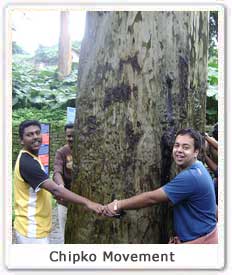 It
was first started in the Chamoli district in the year 1973 and from there it
spread to the other parts of the country. There is one very famous story
about the girl, Amrita Devi, who died while trying to save the trees grown
in her village. The village was under the rule of the local Maharaja, who
desired to built a palace for his family. He ordered his servants to bring
wood from the nearby village. When the wood cutters arrived the village to
cut the tress, Amrita and other women of the village jumped in front of the
trees and hugged them. She said they will have to cut her first before the
trees. The servants were helpless to follow the orders and cut the tree.
Amrita Devi died on the spot. Before offering her head to the Maharajas
servants, Amrita enchanted :- “seir santhe runkh raheb, to bhee
sastojan” (it is till a small price to pay if at the cost of my
head the tree is saved).
It
was first started in the Chamoli district in the year 1973 and from there it
spread to the other parts of the country. There is one very famous story
about the girl, Amrita Devi, who died while trying to save the trees grown
in her village. The village was under the rule of the local Maharaja, who
desired to built a palace for his family. He ordered his servants to bring
wood from the nearby village. When the wood cutters arrived the village to
cut the tress, Amrita and other women of the village jumped in front of the
trees and hugged them. She said they will have to cut her first before the
trees. The servants were helpless to follow the orders and cut the tree.
Amrita Devi died on the spot. Before offering her head to the Maharajas
servants, Amrita enchanted :- “seir santhe runkh raheb, to bhee
sastojan” (it is till a small price to pay if at the cost of my
head the tree is saved). The incident inspired the several other rural womens, who in 1970's launched such similar movements in different parts of India. The incident inspired the several other rural womens, who in 1970's launched such similar movements in different parts of India.It is really surprising that the women of that age were better aware about the significance of forests. The rural women in India actively participated in the movement, who knows about deforestation and its future consequences. Some of the key women leaders who fought for the protection of forests, whom they call it their maternal mother were Gaura Devi, Sudesha Devi, Bachni Devi, Dev Suman, Mira Behn, Sarala Behn and Amrita Devi.
The Chipko Movement gained momentum under Sunderlal Bahuguna, an eco activist, who spent his whole life persuading and educating the villagers, to protest against the destruction of the forests and the Himalayan mountains by the government. It was he, who made appeal to the Prime Minister of India Mrs Indira Gandhi to ban the cutting of tress. He shouted the slogan 'ecology is the permanent economy'. Another main leader of the movement was Mr. Chandi Prasad Bhatt, who advocated the development of small scale local industries, which were based on the sustainable use of the forests resources for the local benefits. There were many slogans that originated during that period. For example :-
“Embrace the trees and
Save then from being felled
The property of our hills,
Save them from being looted”
Another one says :-
“Let us protect and plant the trees
Go awaken the villages
And drive away the axeman”
One of the major achievement of the Chipko movement was the ban on cutting the trees for the 15 years in the forests of Uttar Pradesh in 1980. Later on the ban was imposed in Himachal Pardesh, Karnataka, Rajasthan, Bihar, Western Ghats and Vindhayas. All this was done on the order of the Indian Prime Minister after the strong protests by the activists through out the country.






